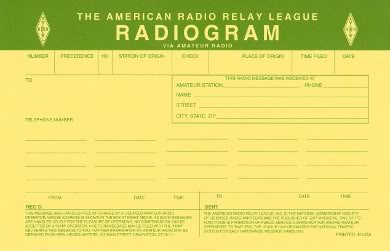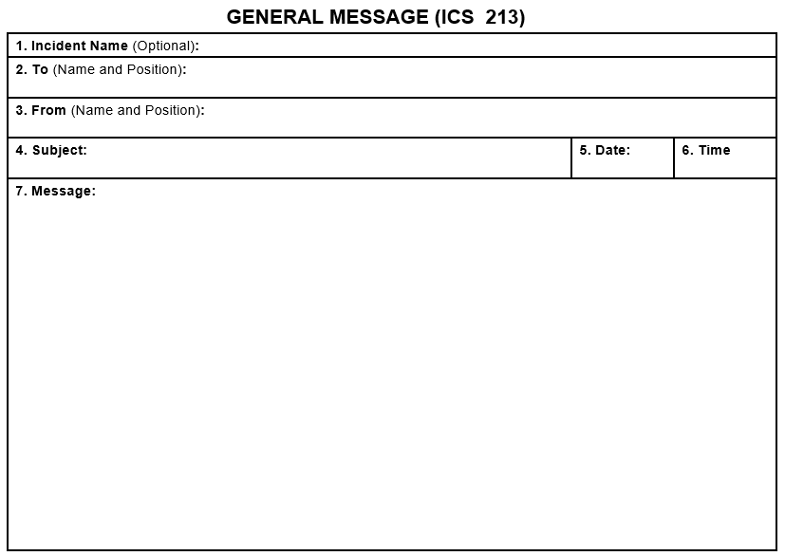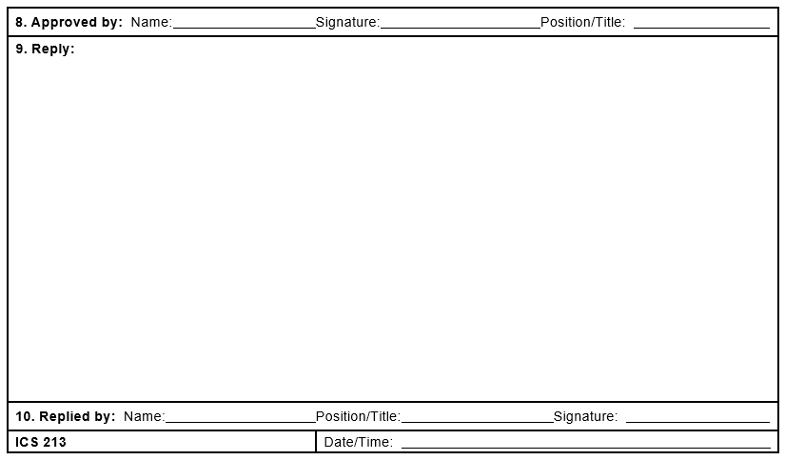Message
Handling
 |
Radiograms
are sent via a network of ham radio operators affiliated with either
the National
Traffic System (NTS), sponsored by the American Radio Relay League, or Radio
Relay International.
These
organizations exist to meet two principle objectives:
1.
Rapid movement of traffic from origin to destination.
2.
Training amateur operators to handle written traffic and participate
in directed
nets.
Traffic
nets operate daily and consists of four different net levels: AREA,
REGION, SECTION, and LOCAL
|
The four levels operate in an orderly time sequence to make a definite
flow pattern for traffic, from origin to destination.
Who can
participate? -
Any licensed radio amateur with an interest
in traffic handling.
The
ARRL Radiogram
The
ARRL provides a standard form for all radiograms transmitted via the
NTS. This uniformity ensures that NTS operators can quickly
and
efficiently handle traffic.
Click here to download a fillable
PDF version of the Radiogram form.
Every
radiogram message originated and handled should contain the following 4
main components:
1.
PREAMBLE
2. ADDRESS
3.
TEXT
4. SIGNATURE |
The Preamble includes
information used to prioritize and track the message and ensure its
accuracy.
This
includes the name, address, city, state, ZIP, and telephone number of
the intended recipient, as complete as possible. (Note that
punctuation is not used in the Addresss section).
The
message information, limited to 25 words or less if possible.
Normal punctuation characters are not used in the text. A
question mark is sent as QUERY, while DASH is sent for a
hyphen.
The letter X is used as a period, (but never afetr the last group of
the text), and counts as a word when figuring the Check. The
letter R is used in place of a decimal in mixed figure
groups.
For example (146R52 for 146.52).
The
name of the party for whom the message was originated. This
may
include additional information such as Amateur Radio call sign, title,
address, phone
number, and so on. |

A.
B.
C.
D.
E.
F.
G.
H.
|
NUMBER
- This indicates the serial number of the message. It is assigned by
the Station of Origin and never changed. Numbering is necessary because
hams may handle dozens of messages daily, and without a numbering
system it would be difficult to identify any given message.
PRECEDENCE
- Determines the order in which traffic is passed. Assign
each
message a Precedence of R (Routine), W (Welfare), P (Priority) or
EMERGENCY.
HX
(Handling Instructions) - Optional, used only if a specific
need
is present. Handling instructions are detailed below.
STATION OF ORIGIN -
The call sign of the station originating (creating) the message.
CHECK
- The number of words or word groups contained in the Body of the
message. (A word group is defined as any group of 1 or more
consecutive characters with no interrupting spaces).
PLACE OF ORIGIN
- The location (city and state) of the party for whom the message was
created and not necessarily the location of the Station of Origin.
TIME FILED
- Optional, used only when the filing time has some importance relative
to the Precedence, Handling Instructions or Message Body.
DATE - The date the
message was filed. |
Precedence

EMERGENCY
PRIORITY
WELFARE
ROUTINE |
Any message having life and
death urgency to any person or group of persons, that is transmitted by Amateur Radio in the absence
of regular commercial facilities. This includes official
messages of welfare
agencies
during emergencies requesting supplies, materials or instructions vital
to relief efforts for the
stricken populance in
emergency areas. On CW and digital modes, this designation
will always be
spelled out. When in doubt, do not use this designation.
Abbreviated
as P on CW and digital modes. This classification is for
important messages having a specific time limit. Official
messages not covered in the emergency category, press dispatches and emergency-related traffic not
of the utmost urgency.
Abbreviated
as W on CW and digital modes. This classification refers to
an inquiry about the health and welfare of an individual in
the disaster area, or to an advisory from the disaster area that
indicates “all is
well.” Welfare traffic is handled only after all emergency and priority
traffic is cleared. The American Red Cross equivalent to an
incoming Welfare message is DWI (Disaster Welfare Inquiry).
Abbreviated
as R on CW and digital modes. Most traffic in normal times
will bear this designation. In disaster situations, traffic
labeled routine should be handled last or not at all, when circuits are
busy with
higher-precedence traffic. |
Handling
Instructions
Handling
Instructions (HX) convey special instructions to operators handling and
delivering the message. The instruction is inserted in the
message Preamble between the Precedence and the Station of
Origin. Its use is optional with the originating stations, but
once inserted it is mandatory with all relaying stations.
PROSIGN
HXA
HXB
HXC
HXD
HXE
HXF
HXG |
INSTRUCTION
(Followed by number). Collect
landline delivery authorized by adressee within _______
miles. (If no number,
authorization
is unlimited).
(Followed
by number). Cancel message if not delivered within ________ hours of
filing time; service originating station.
Report
date and time of delivery. (TOD) to originating
station.
Report
to originating station the identity of station from which received,
plus date and time. Report identity of station to which
relayed,
plus date and time, or if delivered, report date, time and method of
delivery.
Delivering
station get reply from addressee, originate message back.
(Followed
by number). Hold delivery until __________ (date).
Delivery
by mail or landline toll call not required. If toll or other
expense involved, cancel message and service originating station.
|
Address
The name, call sign (if going
to a ham), street address or P.O. Box, city, state (abbreviated)
and ZIP code of the person the message is being sent to. Clear,
complete addresses are desirable. Include in the address of your
message all matter that is necessary to enable operators to identify,
contact, or locate the adressee.
Telephone
Number: Be sure to include the area code and double-check the
number!!
Note - Digital and Packet NTS messages are routed via ZIP code.
Received
At
This Radio Message was Received at: Your station
identification.
Message
Body

TEXT:
The message information, limited to 25 words or less, if
possible. Normal punctuation characters are not used in the text. A
question mark is sent as QUERY, while DASH is sent for a
hyphen.
The letter X is used as a period (but never after the last group of the
text), and counts as a word when figuring the CHECK.
The letter R is used in place of a decimal in mixed figure groups.
Example: 146R52 instead of 146.52
SIGNATURE: There
is no “Signature” field. Just write it in below the text;
Name
and call sign of author - include phone number if not a ham or if not
known on an NTS net.
Received From

Sent To

|
Call sign or
individual from whom you received the message and date and time of
receipt. Time may be either your local time or UTC time. Make
sure the date agrees with the time. (Remember UTC time is ahead of
EST and can cause the
date to roll forward).
Call sign you sent to or passed the message to, or to whom you delivered it, with
date and time. Also good to note delivery method for your
own reference. (i.e., via phone or left on voice mail).
Always leave your call back
number if message was left on
voice mail!
|
Numbered
Radiograms
Numbered
radiograms are an efficient way to convey common messages.
The
letters ARL are inserted in the preamble in the check and in the text
before spelled-out numbers. Note that some ARL texts include
insertion of information.
For a complete list of Numbered Radiograms, click here.
How
to Deliver a Radiogram
- Via
telephone or hand delivery
is preferred.
- Okay
to leave on voicemail or answering machine
if you’re
comfortable you have reached the right person.
- A
Radiogram postcard may be mailed if the receipient cannot be reached by
phone.
- Service
originating station to inform if you cannot deliver the message, or if
they requested confirmation.
When
operating phone, it is customary to use introductory words such as
"figures" prior to sending numbers, "mixed figures" or "mixed group
figure" before sending a combination of letters and numbers, and
"initial" prior to sending a single letter, such as I or A.
This
helps the receiving station to copy the message more clearly and with
less error.
In the example below, you'll learn how these are used in an actual
message.
Example
of a message sent by
voice (From the ARRL Public Service Manual)
Message
Example:
(Preamble)
26 R N3XYZ 17 BANGOR ME JUL 24
(Address)
JOHN R SMITH
23
OAK DRIVE
PHILADELPHIA
PA 19034
215
555 2345
(Text)
I WILL ARRIVE TOMORROW AT
6PM X CAN YOU PICK ME UP AT
THE AIRPORT QUERY 73
(Signature)
BILL
KEY:
“.” = word pause, “.. ” = group pause, “.. .. ” = copy pause, (//)
= release of PTT, (/.../)
=
required listening pause.
Prowords, operational words
and introductory words are shown lower case. Try sending the prowords
and operational
words in a slightly higher pitched voice, the introductory words in a
slightly lower pitched voice,
or vice versa. TX is the sender, RX the receiver, on a net frequency.
(See STATION OPERATIONS for
details on off frequency calls.)
RX:
“W3RX ready to copy”. (In severe conditions the RX station may ask the
sender to
repeat each group 2 or 3 times and/or use letters or phonetics to spell
all groups).
TX:
“W3TX” (Optionally informs RX of quantity and if listening between
groups.)
“number..
TWO.SIX.. ROUTINE..
NOVEMBER THREE X-RAY YANKEE ZUZU.. ONE.SEVEN.. BANGOR.. MAINE..
JULY.. TWO.FOUR”.. ..
“JOHN.. initial.ROMEO.. SMITH I spell SIERRA MIKE INDIA TANGO HOTEL.. .. figures TWO THREE.. OAK I
spell O.A.K.. DRIVE.. .. PHILADELPHIA.. .. .. PENNSYLVANIA.. figures ONE
NINER ZERO THREE FOUR.. .. figures TWO ONE
FIVE..
FIVE FIVE FIVE.. TWO THREE FOUR FIVE.. break” (/.../) (interruption
pause)
“initial.INDIA.. WILL.. ARRIVE.. .. TOMORROW.. AT.. .. mixed group
figure SIX PAPA
MIKE.. initial X-RAY.. CAN.. YOU.. .. PICK.. ME.. UP.. .. AT.. THE..
AIRPORT.. ..
QUERY.. figures SEVEN THREE.. break.. BILL I spell BRAVO INDIA LIMA
LIMA.. end..
no.more”
RX:
“ROGER.. W3RX” (or “ROGER.. 73 W3RX”, etc.), or asks for fills, and
acknowledges the
message when done.
TX:
“W3TX” (or “THANKS 73 W3TX”, etc.); (The exchange is complete.)
*
PTT releases (//) are not shown in this example. On fast VOX or PTT
operation, release or
listen after every group or phrase. The expected interruption pause
(/.../) is shown.
Notes:
On FM repeaters, due to audio delays and receive site delays, it may be
impractical to break after
groups without loss of audio.
In this case, the PTT switch is released only at the customary expected fill breaks. When
sending long messages or batches the receiving operator may be forced to say “go ahead” by
saying “over” at the break point between messages, thus confirming continuing good copy. Keep
the repeater transmission time limiter in mind also.
The
ICS-213 Message Format
The ICS-213
message form is the standard format used by FEMA and
EmComm organizations. The General Message (ICS-
213) is used by incident dispatchers to record
incoming messages that cannot be orally transmitted to the intended
recipients. The ICS-213 is also used by Incident Command Post
and other incident personnel to transmit messages (e.g., resouce order,
incident name change, other ICS coordination issues, etc. to the
Incident Communications Center for transmission via radio or telephone
to the addressee. The form is used to send any message
or notification to incident personnel that require
hard-copy delivery.
The ICS-213
may be initiated by
incident dispatchers and any other
personnel on an incident.
Distribution - Upon completion, the ICS-213 may be delivered to the
addressee and/or delivered to the incident Communication Center for
transmission.
Another variation of this form is the ICS-213RR,
which is specifically used for Resource Requests.

| Block Number |
Block Title |
Instructions |
| 1 |
Incident Name
(Optional) |
Enter the
name assigned to the incident. (Optional) |
| 2 |
To (Name and
Position) |
Enter
the name and position the General Message is intended for. For all
individuals, use at least the first initial and last name. For Unified
Command, include agency names. |
| 3 |
From (Name and
Position) |
Enter
the name and position of the individual sending the General Message.
For all individuals, use at least the first initial and last name. For
Unified Command, include agency names. |
| 4 |
Subject |
Enter
the subject of the message. |
| 5 |
Date |
Enter
the date (month/day/year) of the message. |
| 6 |
Time |
Enter the time (using the
24-hour clock) of the message. |
| 7 |
Message |
Enter the content of the
message. Try to be as concise as possible. |

| Block Number |
Block Title |
Instructions |
| 8 |
Approved by
Name
Signature
Position/Title |
Enter the
name, signature, and ICS position/title of the person approving the
message. |
| 9 |
Reply |
The
intended recipient will enter a reply to the message and return it to
the originator. |
| 10 |
Replied by
Name
Position/Title
Signature
Date/Time |
Enter
the name, ICS position/title, and signature of the person replying to
the message. Enter date (month/day/year) and time prepared (24 - hour
clock). |
Local,
Section, and Regional Traffic Nets
LOCAL
WSSM Meeting on the Air
WSSM-ECT Net
Newcomers' Roundtable
MAINE SECTION
Maine Dirigo Net (DMR)
Seagull Net
Maine Public Service Net
Maine ARES Net
Maine Slow Speed Net
Pine Tree Net
NEW
HAMPSHIRE SECTION
Granite State Traffic Net
NH ARES Net
VT-NH Traffic Net
1st REGION (New
England)
Afternoon (Cycle 2)
Afternoon (Cycle 2)
Evening (Cycle 3)
RRI Evening (RRIE)
Evening (Cycle 4)
New England DMR Net
NE DMR SKYWARN Net
EASTERN AREA NET (EAN)
Afternoon (Reg 1, Cycle 2)
Afternoon, (Reg 1, Cycle 2)
Afternoon, (Reg 2, Cycle 2)
MARITIME
Maritime Mobile Service Net
|
Schedule
3 Thur
4 Thur
Sundays
Sundays
Mon - Sat
Sundays
Sundays
Mon - Fri
Daily
Daily
Saturdays
Daily
Daily
Daily
Daily
Daily
Daily
Mondays
Thursdays
Sat, Sun
Mon - Fri
Daily
Daily
|
Time
7 PM
local
7 PM
local
6:45pm
10 AM local
5 PM local
9 AM local
6:30 PM local
6 PM local
7 PM local
0200Z
1330Z (0830L)
0000Z
1845Z
2030Z
2330Z
0000Z
0230Z
8 PM local
7:30 PM local
1930Z
1930Z
1930Z
1700Z
|
Frequencies
147.090
(+ / 100.0)
449.225 (- / 103.0)
147.090 (+ / 100.0)
ME Statewide TG (3123)
3940 kHz
3940 kHz
3940 kHz
3585 kHz
3596 kHz
146.940 (- / 114.8)
3973 kHz (7273 kHz Alt)
3539 kHz
3948 kHz
3948 kHz
3570 kHz
3552 kHz (7052 kHz Alt)
3598 kHz
NE Wide TG (3181)
SKYWARN TG (759)
7050 kHz
7243 kHz
7220 kHz
14300 kHz
|
Notes /
Manager
Manager:
KB1HNZ
Manager:
KB1HNZ
Manager: KJ6JBH
Manager: KC1HBM
Section Wide Emergency Net
Emergency Traffic & Weather
Emergency
Traffic & Weather
Traffic
Traffic
Manager: K1UAF
Manager:
N4COY
Manager: KM1N
Manager: N1UMJ
Manager:
N1UMJ
Manager: W1KX
Manager: WB8WKQ
Manager: W1KX
Manager: NE1B
Manager: N1PZP
Manager: KB1AJ
Manager: KB1AJ
Manager: W8YS
Manager: K4EDX
|

Additional
Resources
ARRL
Net Directory –
Excellent NTS reference with net listings by state
($5 from ARRL).
Online version is accessible free at the
ARRL web site.
NTS Manual –
Detailed
reference on NTS message handling ($1 from ARRL ), also
available on ARRL web site.
NTS
Policies (Cycle Time Schedule)
Third-Party Operating Agreements
NTS
Homepage
– on
ARRL website, provides all
the information you’ll need to
get started
with traffic handling, including the Policy Manual, and updated net
directory.
|
|